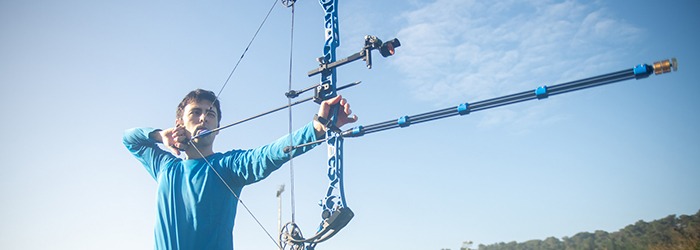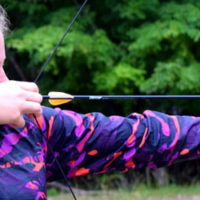If you’re trying to improve your aim by shooting a compound bow at large distances or designing an archery range in your backyard, you might be wondering what’s the maximum distance your bow can shoot. In this post, we’ll take a look at the numbers.
The maximum range of a compound bow with an IBO setup is typically around 63-135 yards. Different bow setups have different ranges, based on the draw weight, draw length, and arrow weight. This range is typically higher than the range where the archer can properly aim, typically around 30-50 yards.
There are a few ways to measure the range of a compound bow, because it all depends on what point we consider as the endpoint of the arrow path. We might consider a few methods:
- Maximal arrow travel distance. This is the distance where the arrow completely stops moving, where we assume the arrow is shot at some specific angle. The 45-degree angle will be the actual maximal distance of the arrow, and the 10-degree angle is the realistic shooting angle.
- Arrow kinetic energy. Kinetic energy determines how much “force” the arrow carries. I’ve calculated the total amount of kinetic energy that the arrow carries, based on the wind resistance, under some assumptions of the arrow shape and weight. It’s known that for big game bowhunting targets 65 [ft lbs] kinetic is required, for medium game 42 [ft lbs] is required, and for small game 25 [ft lbs] is required. I’ve calculated the distances where the arrow kinetic energy drops below these requirements.
- Arrow Momentum. Similarly, arrow momentum determines arrow penetration. For big game targets, 6.7 [fps lbs] is required, for medium game 9.8 [fps lbs] is required, and for small game targets, 13.9 [fps lbs] is required. I’ve calculated the distance where arrow momentum drops below these requirements.
Based on these measures, I’ve created a table, listing the different measures for all the bow of the popular brands. I’ve assumed an IBO setup for all the bows listed below – and we’ll consider other setups later in this post.
Bow Range Table
The data in the following table contains the effective range calculation results for all compound bows of the popular brands of 2021 (over 100 bows!). I’ve put all the data into complicated excel sheets (based on data from the bow specs) and physics calculations, analyzed the results, and compiled this giant table. For these calculations, I’ve assumed you’re shooting a 70 lbs bow and a 350-grain arrow (meaning, a standard IBO setup). We’ll discuss different setups later. You can see the full compound bow range dataset at this link.
Of course, all of the range calculations are a broad approximation, assuming good environmental conditions and a specific bow setup (I’ve assumed IBO setup, which might be really off for you – read below for details).
Based on this table, I’ve aggregated a few pieces of information:
- The average IBO bow speed of a compound bow is 325 fps, where most bows are within 20 fps of this speed.
- The average maximum range for standard arrow shooting of a compound bow is 365 yards. and most compound bows are within 77 yards of this range.
- The average distance for arrow kinetic energy of 65 [ft lbs] is 99 yards. for 42 [ft lbs] is 271 yards, and for 25 [ft lbs] is 476 yards, all higher than standard shooting distances of archers. Most compound bows maintain 65 [ft lbs] within 63-135 yards. This means in most bowhunting situations under 90 yards, your arrow maintains most of its kinetic energy.
- The average distance for arrow momentum of 13.9 [lbs fps] is 130 yards, for 9.8 [fps lbs] is 408 yards, and for 6.7 [fps lbs] is 710 yards. These are all much higher than most bowhunting scenarios.
These realizations should provide a more clear idea of how far arrows actually travel from a compound bow, and how much energy and momentum your arrows carry over large distances. We’ll first analyze how I got to these numbers, and then figure out how to take these conclusions and take into account your specific bow setup.
If you also wonder how far recurve bows shoot, I did some simple calculations to figure that out, in a previous post.
Things that might affect your bow range
There are multiple aspects that can affect your bow’s maximum range (source):
- Draw weight. It’s common knowledge that reducing your draw weight by 10 lbs will reduce the speed of your arrows by about 15-20 fps, which translates to a reduction of about 4-6 yards per 10 lbs.
- Arrow weight. It’s often said that every 10 grains added to your arrow weight reduces around 2-3 fps of speed, which causes your bow range to decrease by around 0.5 yards.
- Draw length. Another common saying is that every inch you reduce of your bow draw length reduces around 10 fps of your bow speed, which reduces your bow range by about 3 yards.
If like most archers, you’re shooting a different setup than the IBO standard, this will help you estimate the maximal distance arrows might travel from your compound bow.
For example, if you’re shooting a 50 lbs draw weight bow, with a 400-grain arrow and draw length of 21″, your range should be about 15 yards lower than the standard. For example, your kinetic energy effective range for big game bowhunting targets will be 77 yards.
Of course, these are just approximations, but they do give a good rule of thumb of your maximal bow range with different setups.
How bow range is calculated
The maximal range calculation was based on simple physics ballistics. The range depends on the angle and is simply the range where the arrow returns back to the same height over the ground it was shot at.
The maximal range the arrow will have will be when shot at a 45 degrees angle, but a 10 degrees angle is a more realistic shooting angle. The 45-degree arrow range turns out to be equal to (bow speed)^2 / 24.1, where the 24.1 comes from earth acceleration. For a realistic 10-degree shooting angle, the distance becomes (bow speed)^2 / 282, significantly lower but more representative of reality.
A more complex calculation takes into account kinetic energy and momentum, all based on air-resistance calculation of how fast the arrow should be based on the traveled distance. This is quite a complex calculation, that results in a different definition of bow range, based on how much force the arrow carries (kinetic energy), and its ability to penetrate a target (momentum), based on its speed.
I’ve used realistic values of air density (source), arrow size, and weight, to estimate how much it slows down over time. The kinetic energy of an arrow, based on its travel distance, is 0.5*(arrow mass)*(initial speed)^2 * exp(-(2.5*10^-3)*distance). The distance where kinetic energy hits some value turns out to be ln((arrow mass)*(initial speed)/(2 * kinetic energy)) / (1.25*10^-3). Obviously, both these equations are much more complex than the ones before.
As for the momentum based on the travel distance is (arrow mass)*(initial speed)*exp(-(2.5*10^-3) * distance). The distance where the momentum hits some specific value is ln((arrow mass)*(initial speed)/(momentum)) / (2.5*10^-3).
I hope these equations help some of you understand how I got to the numbers in the table. To those of you that didn’t understand the calculations, at least you now know how much effort was put into this post ????.
Conclusions
Based on the calculations in the tables, and the speeds reported by the bow manufacturers, most compound bows have a maximum range of around 366 yards, and an effective range of around 92 yards, where the arrows remain effective for big game bowhunting targets.
For most archers, this effective range is much higher than the range when they can confidently aim the bow and consistently hit the target.
We also considered how different setups than IBO, which is quite uncommon, affect bow speed. This is an essential section to read, because your compound bow range might actually be very different from the one calculated based on the IBO setup.
I hope this post gave you an idea of what your bow range should be, and how its calculated.



